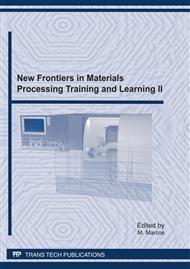p.50
p.58
p.65
p.74
p.83
p.93
p.99
p.104
p.112
Machining Apprenticeship Based on Experimental Training Practice
Abstract:
This article describes a practical machining training aiming that the students acquire the theoretical-practical knowledge of chip formation process. The training takes place after theoretical lessons of machining processes. Thus, this practice allows strengthening the knowledge gained during the lessons. The practical training lasts for five hours, and the student assisted by the teacher analyses the influence of some machining entry parameters (cutting speed, feed rate...) on exit parameters like: (I) cutting forces and power consumption, (II) surface roughness, and (III) chip typology. The practical session is carried out on an experimental set-up (Lathe CNC Danobar 65) equipped with sensors and devices to measure forces (sensor Kistler 9121) and power consumption. In addition, a portable rugosimeter (Hommelwerke) is employed to perform surface roughness measurements. No especial devices are needed for the chip typology analysis. In the case of cutting forces and power consumption, the following input parameters influences are analysed: feed rate, depth of cut and cutting speed. In the case of surface roughness analysis, the following input parameters influences are analysed: feed rate and nose radius of the cutting insert. Finally, regarding chip typology feed rate and depth of cut are examined. The experimental results are compared with model predictions (theoretical calculations) for the three issues studied. The students have to compare both results: theoretical an empirical and they need to explain the reasons when discrepancies appear. Results obtained during the last years demonstrate the student acquires better knowledge of the machining process, and at the same time realises of the process complexity.
Info:
Periodical:
Pages:
83-92
Citation:
Online since:
July 2011
Authors:
Keywords:
Price:
Сopyright:
© 2011 Trans Tech Publications Ltd. All Rights Reserved
Share:
Citation:


